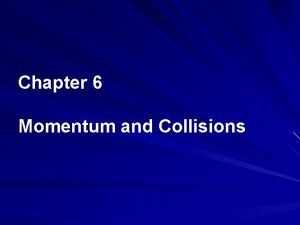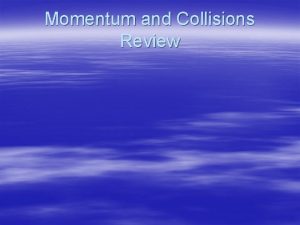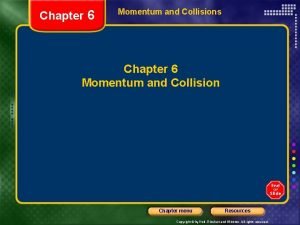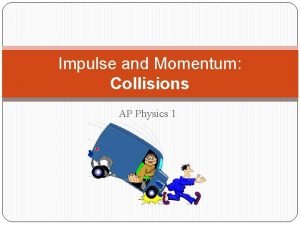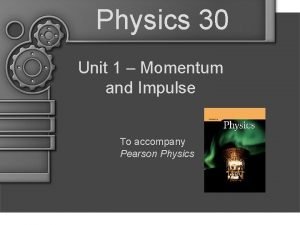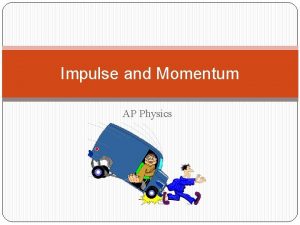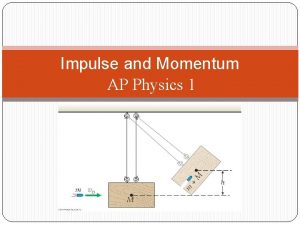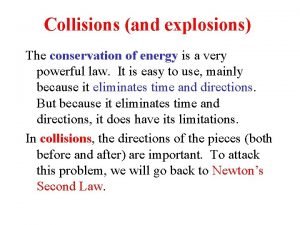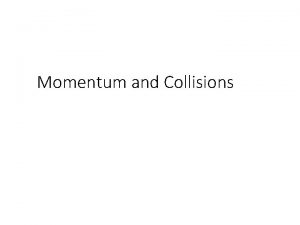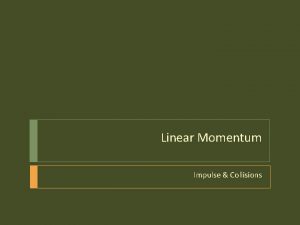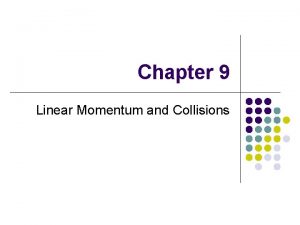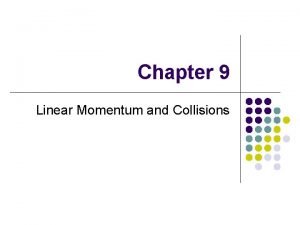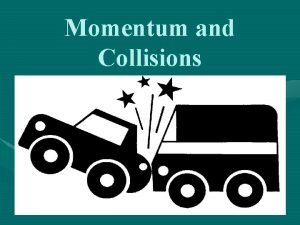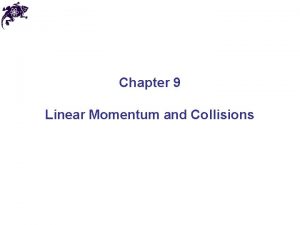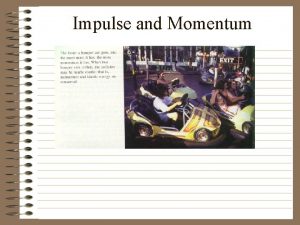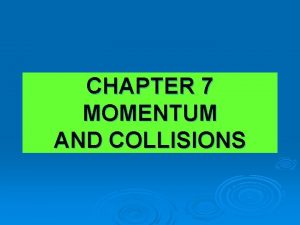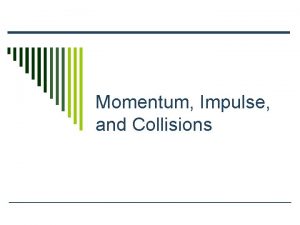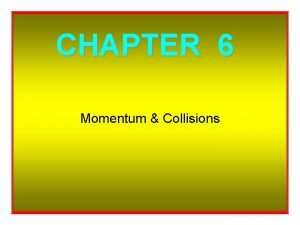Physics 201 8 Linear Momentum and Collisions Linear














- Slides: 14

Physics 201 8: Linear Momentum and Collisions • Linear Momentum and its Conservation • Impulse and Momentum • Collisions • Elastic and Inelastic Collisions in One Dimension • Two Dimensional Collisions • The Center of Mass • Motion of a System of Particles • Rocket Propulsion

Linear Momentum and its Conservation Linear momentum p = mv Newtons Second law dv dp F tot = ma = m = dt dt (if the mass is constant º closed system ) dp =0 F tot = 0 Û dt p = CONSTANT Û Dp = 0

F 12 1 2 F 21

Impulse and Momentum dp = Fdt ò ò Þ dp = Dp = Fdt = I I is called the Impulse of the force I= ò F dt =area under force versus time gra Dp I F= = Dt Dt

Collisions Basic Assumption Forces during the collision dominate all other forces present, so only they need be considered This assumption implies that only contact forces between the objects are important , i. e. that the system is closed This in turn implies that the Total Linear Momentum of the system is conserved

Perfectly Inelastic Collisions The two particles stick together after the collision Þ v 1 f = v 2 f Thus using Dptot = 0 in one dimension m 1 v 1 i + m 2 v 2 i = m 1 v f +m 2 v f = v f (m 1 + m 2) m 1 v 1 i + m 2 v 2 i Þ vf = (m 1 + m 2 )

Elastic Collisions both Momentum ANDKinetic Energy are conserved m 1 v 1 i + m 2 v 2 i = m 1 v 1 f + m 2 v 2 f 1 1 m 1 v 1 i 2 + m 2 v 22 i = m 1 v 1 f 2 + m 2 v 22 f 2 2 éÞ 1 m v 2 - v 2 = 1 m v 2 - v 2 1 ( 1 i 1 f ) 2 ( 2 f 2 i ) 2 êÞ m 1 (v 1 i - v 1 f )(v 1 i + v 1 f ) = m 2 (v 2 f - v 2 i )(v 2 f êFrom conservation of total momentum(1) eq. ê m v - v 1 f ) = m 2 (v 2 f - v 2 i ) ê 1 ( 1 i ê (v 1 i + v 1 f ) = (v 2 f + v 2 i ) ë Þ v 1 i - v 2 i = - (v 1 f - v 2 f ) (1) (2 ) ù ú + v 2 i )ú ú ú û

Two Dimensional Collisions d=impact parameter


The Center of Mass In a system of two or more particles, the system moves as though all the mass were concentrated at a point. That point is called the center of mass. å 1 r = = mr å M m å åm (x i + y j + z k) 1 x i + y j+ z k = m (x i + y j + z k) = Må m k rk k =1, n cm k k k =1, n cm cm cm k k k =1, n k k k

Center of mass of extended objects 1 rcm = M ò 1 rdm= M object ò rr(r)dr; r = (x, y, z); ; dr = dxdydz object dm r(r) = ; M= d. V ò dm object c 1 xcm = M ò 1 xr(r)dr; ycm = M object ò 1 yr(r)dr; zcm = M object ò zr(r)dr object

Motion of a System of Particles

The effect of an external force is to change the momentum of the entire system. If the external force is zero the system maintains a zero or constant velocity and the total momentum of the system is conserved

Rocket Propulsion A rocket is a system with mass M moving at a velocityv. When the gases are expelled with exhaust velocity v e , then the rocket changes its velocity by d v. Thus through conservation of momentum M dv = - ved. M é M v i = ( M - d M )v f - d M v e ù ê M d v = - v d M if M ú d > > M ë û e Þ ò dv = - ve ò d. M M æ M ö i ÷ Þ D v = v e ln ç èMfø Thrust: F = M dv d. M = - ve dt dt
 Elastic collision.
Elastic collision. Momentum and collisions
Momentum and collisions Momentum and collisions review
Momentum and collisions review Chapter 6 momentum and collisions
Chapter 6 momentum and collisions Momentum is conserved in all collisions
Momentum is conserved in all collisions Units of impulse
Units of impulse Linear impulse
Linear impulse Conceptual physics momentum
Conceptual physics momentum Physics 03-06 impulse and momentum answer key
Physics 03-06 impulse and momentum answer key Momentum and impulse physics 30
Momentum and impulse physics 30 Ap physics 1 momentum and impulse
Ap physics 1 momentum and impulse Ap physics momentum and impulse
Ap physics momentum and impulse What is momentum in physics
What is momentum in physics A freight train is being assembled in a switching yard
A freight train is being assembled in a switching yard Collisions and explosions
Collisions and explosions

